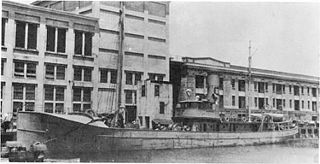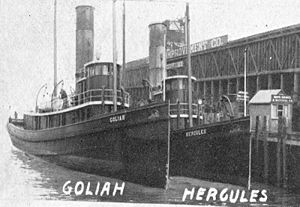
The first USS Warrington (DD-30) was a modified Paulding-class destroyer in the United States Navy during World War I. She was named for Lewis Warrington.

The second USS Conestoga (SP-1128/AT-54) was an ocean-going tug in the United States Navy. Commissioned in 1917, it disappeared in the Pacific Ocean in 1921. The fate of the vessel was a mystery until its wreck was positively identified in 2016.

USS Owl (AM-2) was an Lapwing-class minesweeper acquired by the U.S. Navy for the dangerous task of removing mines from minefields laid in the water to prevent ships from passing.
USS Cormorant (AM-40) was an Lapwing-class minesweeper acquired by the United States Navy for the dangerous task of removing mines from minefields laid in the water to prevent ships from passing.

USS Grebe (AM-43) was a Lapwing-class minesweeper in the United States Navy.

USS Flamingo (AM-32) was a Lapwing-class minesweeper built for the United States Navy near the end of World War I. After service overseas clearing mines after the Armistice, the ship was laid up until 1922 when she was transferred to the United States Department of Commerce for use by the United States Coast and Geodetic Survey. Renamed USC&GS Guide, the ship operated as a survey vessel along the West Coast of the United States for 17 years, making significant contributions to navigation, hydrographic surveying, and oceanography. In June 1941, Guide was transferred back to the Navy, converted into a salvage ship, and renamed USS Viking (ARS-1). As Viking, she worked primarily from bases in California until 1953, when she was sold for scrapping.

The auxiliary patrol vessel USS Yacona (SP-617) was built in 1898 in Scotland as a civilian steam yacht of the same name. Later, she was renamed Amélia as a survey yacht of the King of Portugal, before reverting to Yacona in 1901. She was acquired by the U.S. Navy in September 1917 and served until 1919 as a patrol vessel in the western Atlantic. In 1921 she was transferred to the Philippines as the governmental yacht Apo, serving until 1932.

USS Genesee (AT-55), formerly Monocacy, was a fleet tug in the U.S. Navy in World War I and World War II built in 1905. She was scuttled on 5 May 1942 at Corregidor to avoid capture. Nevertheless, she was raised by the Japanese and designated as Patrol Boat No. 107. She was sunk by American planes on 5 November 1944.

USS Wadena (SP-158) was a converted yacht patrol vessel of the United States Navy during World War I. She was built in 1891 in Cleveland, Ohio, as a steam yacht for Jeptha Homer Wade II of Cleveland and New York City. During her Navy career, Wadena made several trips escorting submarine chasers across the Atlantic Ocean, and, later, patrolling in the Atlantic and Mediterranean. on 26 February 1918 Wadena came to the aid of sinking tug Mariner and rescued all of her crew.

USS Lykens (SP-876/AT-56) was a steam tugboat purchased from the Reading Company by the United States Navy in 1917. Because she was privately built, she was not of a ship class. She was the only U.S. Navy ship of this name.

The first USS Vedette (SP-163) was a commercial yacht built in 1899. At the outbreak of World War I, the yacht was leased by the United States Navy, and was used as a section patrol craft in the North Atlantic Ocean. She served honorably during the war, rescuing survivors at sea, and attacking a German U-boat. At war’s end, she was converted to her original configuration and returned to her owner, the railroad executive, financier, and philanthropist Frederick W. Vanderbilt (1856-1938) of New York City.

USS James (SP-429) — also known as USS W. T. James (SP-429) — was a steam trawler acquired by the United States Navy during World War I. She was converted into an armed minesweeper and assigned to the European Theater, where she performed varied tasks, including minesweeping, patrolling, and escorting of larger ships in convoy. In 1919, while returning to the United States, she was severely damaged in a storm off the French coast, and sank. Her crew were rescued.
The first USS Barnegat (SP-1232) was a commercial tugboat acquired by the U.S. Navy during World War I. She was armed with a 3-inch gun and sent to Brest, France, to perform towing services for Allied ships. Post-war, she returned to the United States, was decommissioned, and was subsequently used on the Delaware River by the U.S. Army Corps of Engineers.

USS Concord (SP-773), later known as USS Mendota (YT-33) and again later as USS Muscotah (YT-33) was a tugboat acquired by the U.S. Navy during World War I. Concord was initially assigned to North Atlantic towing duties, and later was assigned as harbor tug at the Washington Navy Yard. She was sold in 1937.

USS Utowana (SP-951) – also known as USS Victorine (SP-951) -- was a fishing trawler acquired by the U.S. Navy during World War I. The Navy had planned to use her as a minesweeper based out of Kittery, Maine; however, Utowana spent most of her service time operating as an armed patrol craft, responsible for escorting Allied ships across the dangerous North Atlantic Ocean. She served through the war and the armistice before returning to the United States for decommissioning.

The sixth USS Niagara (SP-136), later PY-9, was a United States Navy patrol vessel in commission from 1918 to 1931 and which served during World War I.

USS Anderton (SP-530), originally to have been USS Raymond J. Anderton (SP-530), was a patrol vessel and minesweeper that served in the United States Navy from 1917 to 1919.

USS Dreadnaught (ID-1951), later YT-534 and YNG-21, was a United States Navy tug that was in service from 1918 to 1944.

USS Sea Rover (SP-1014), later AT-57, was a United States Navy armed tug in commission from 1918 to 1921.

USS Arctic (SP-1158) was a wooden-hulled steam tug acquired by the US Navy during World War I. Arctic was briefly employed as a convoy escort during the war and later used to tow targets and transport ammunition. She was returned to commercial service in 1919.


















